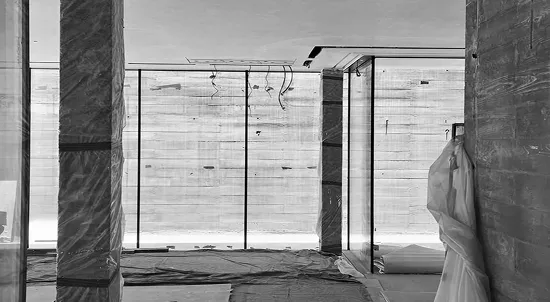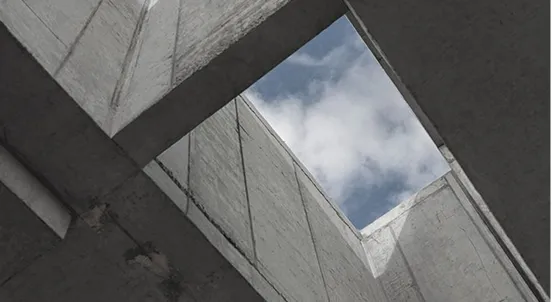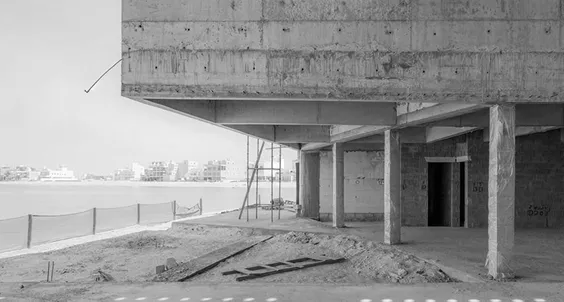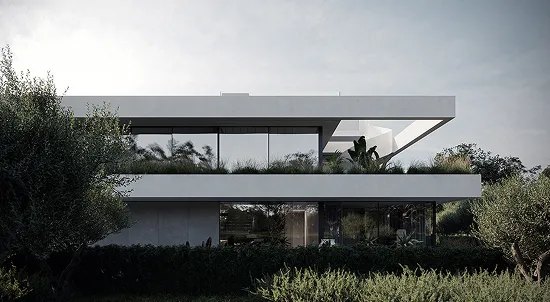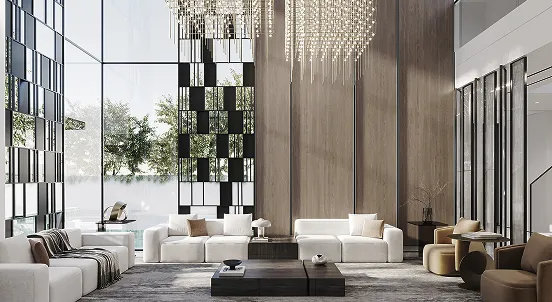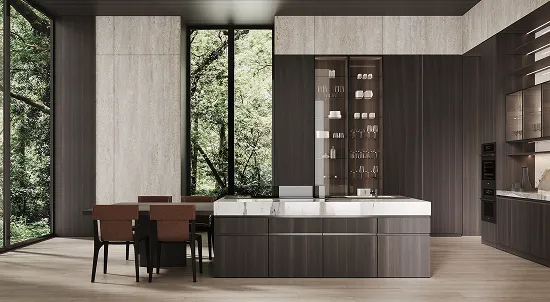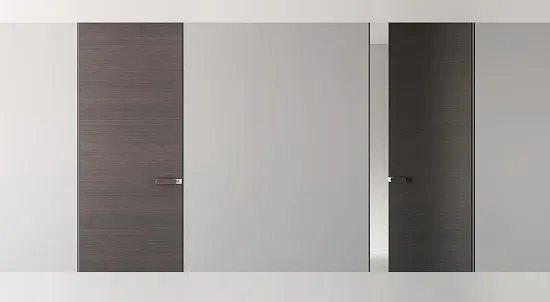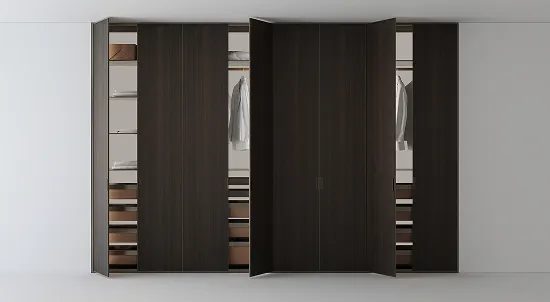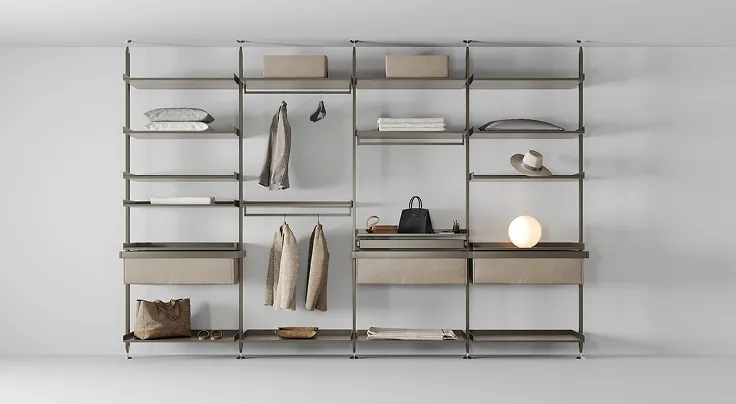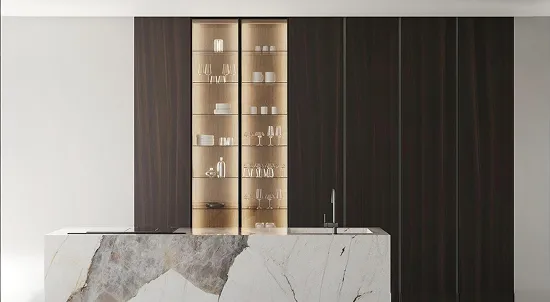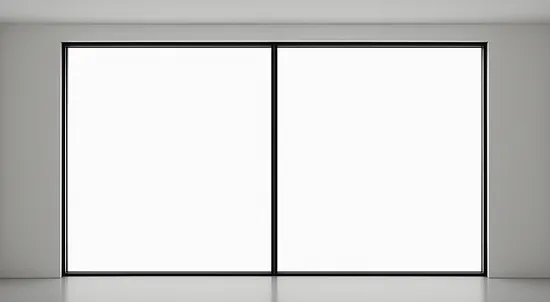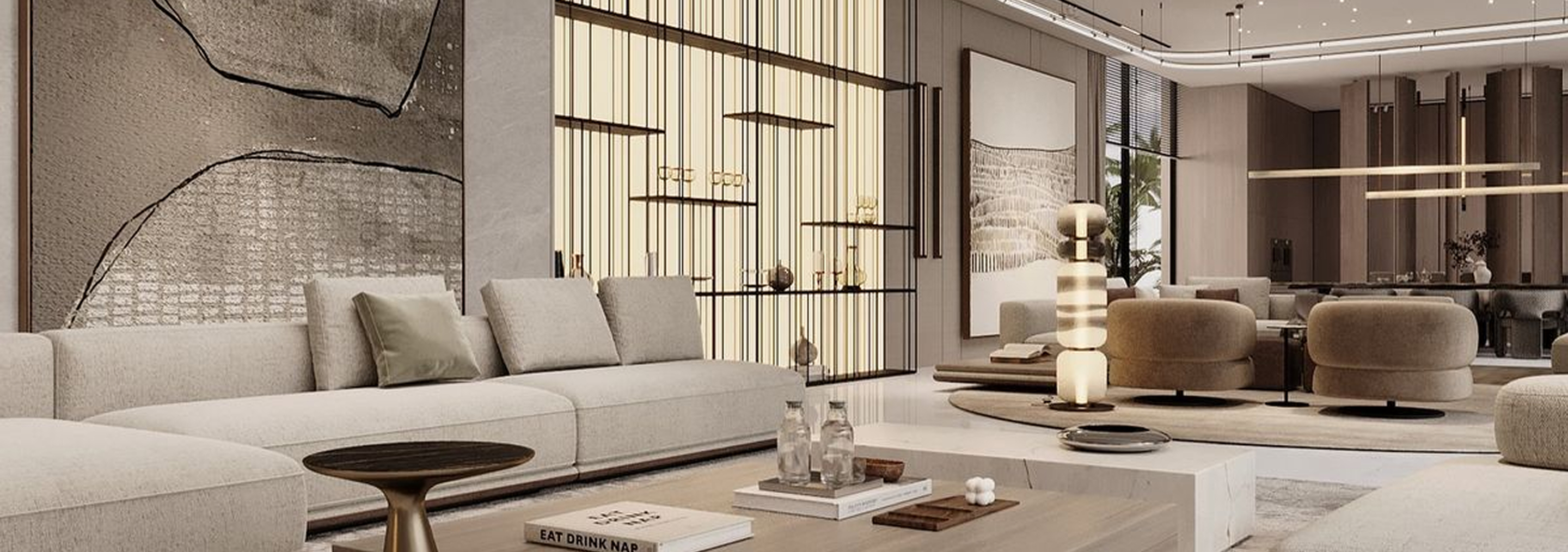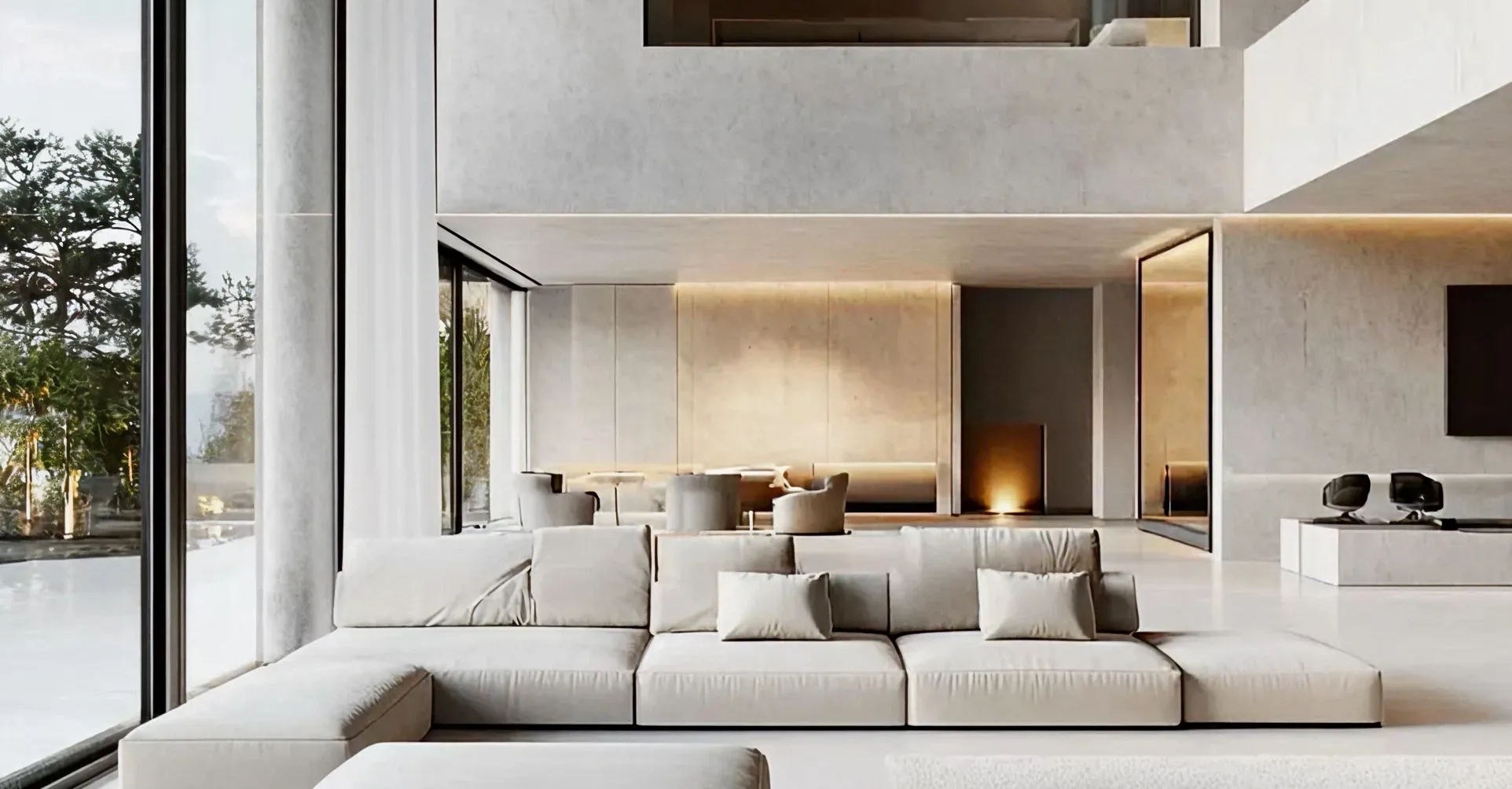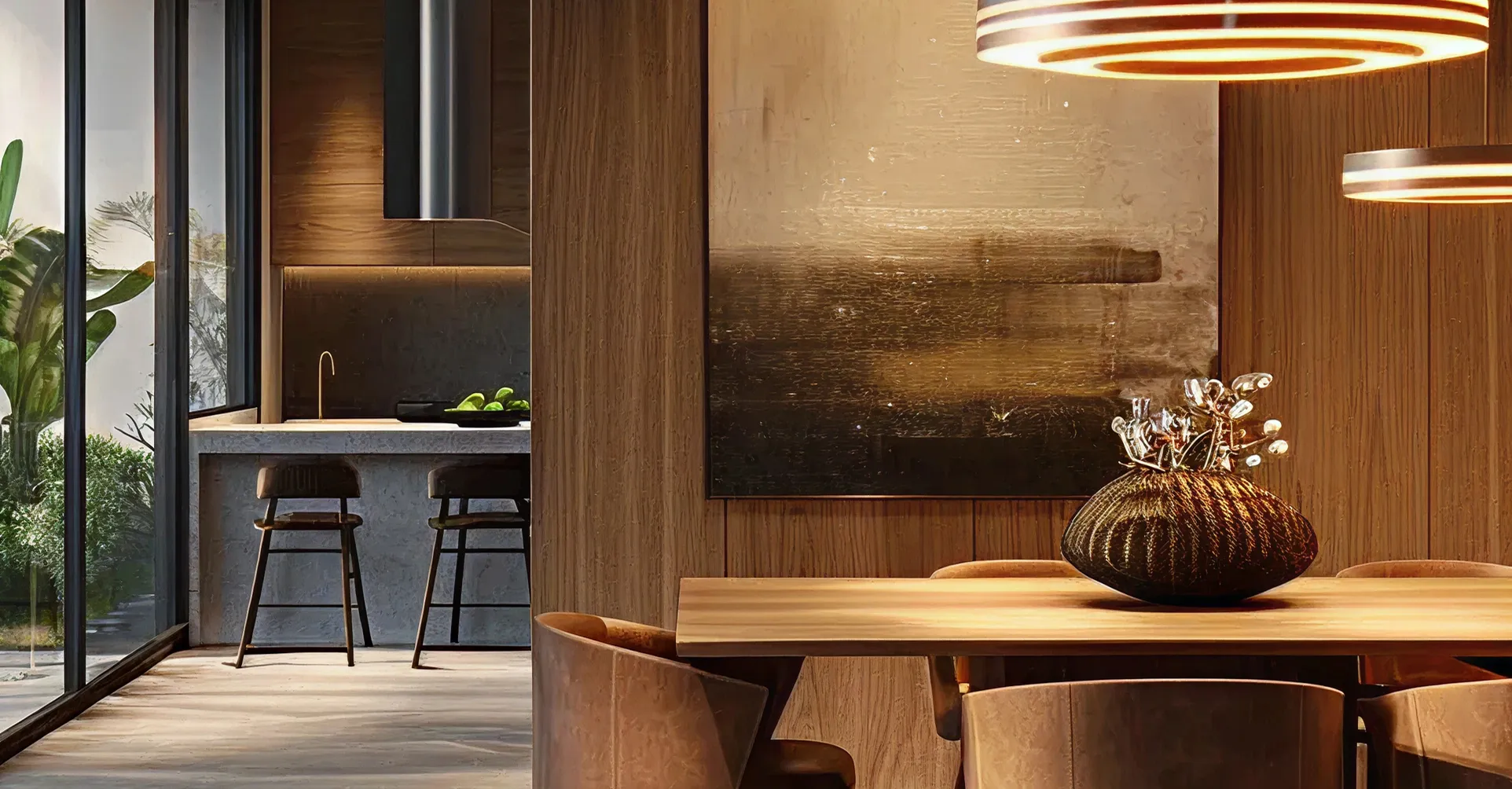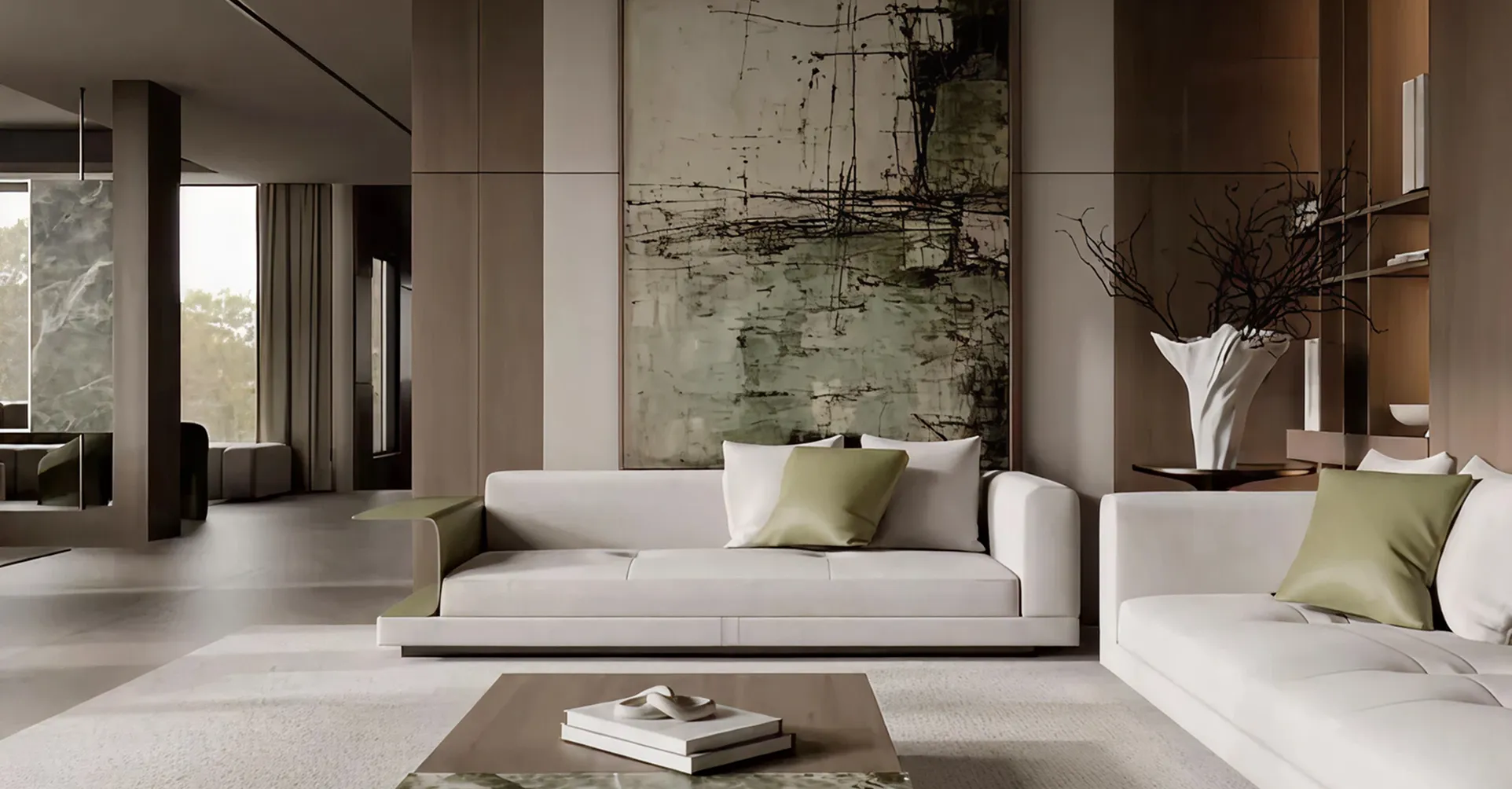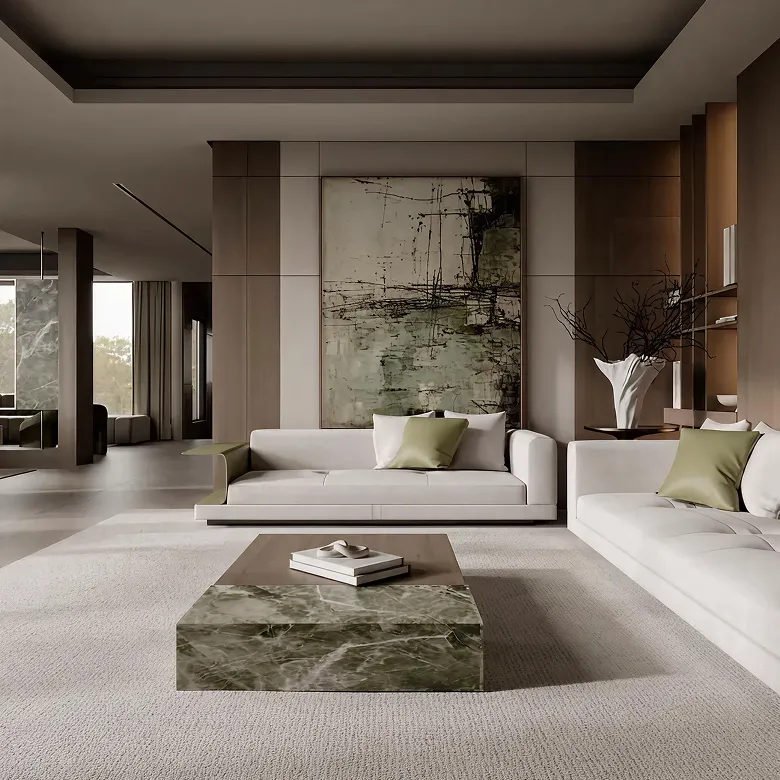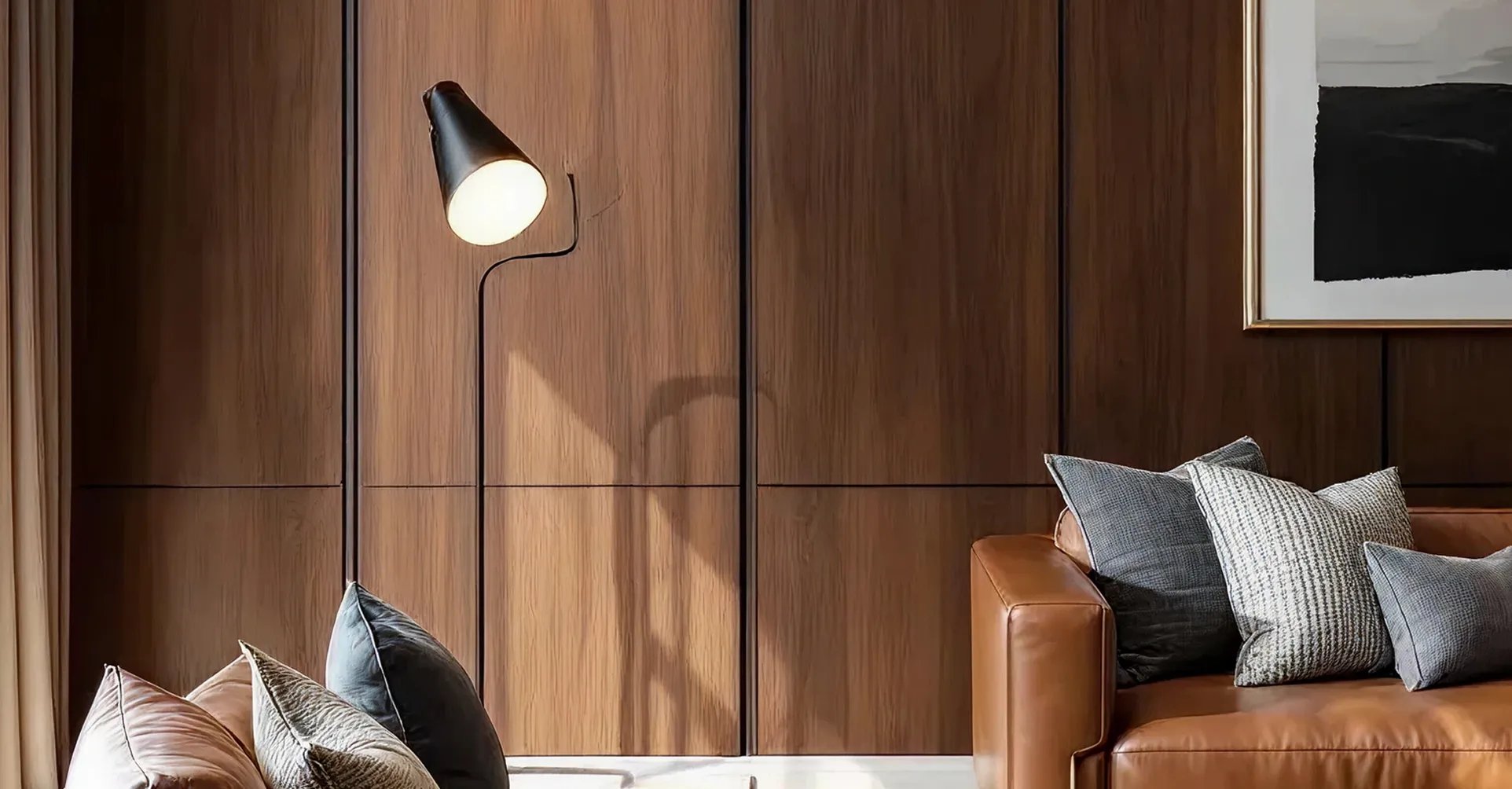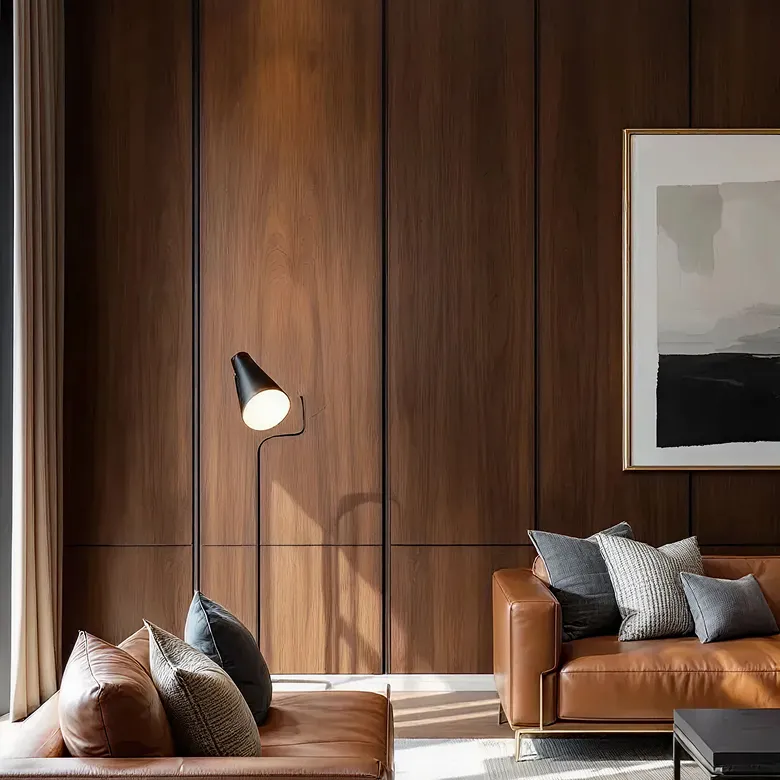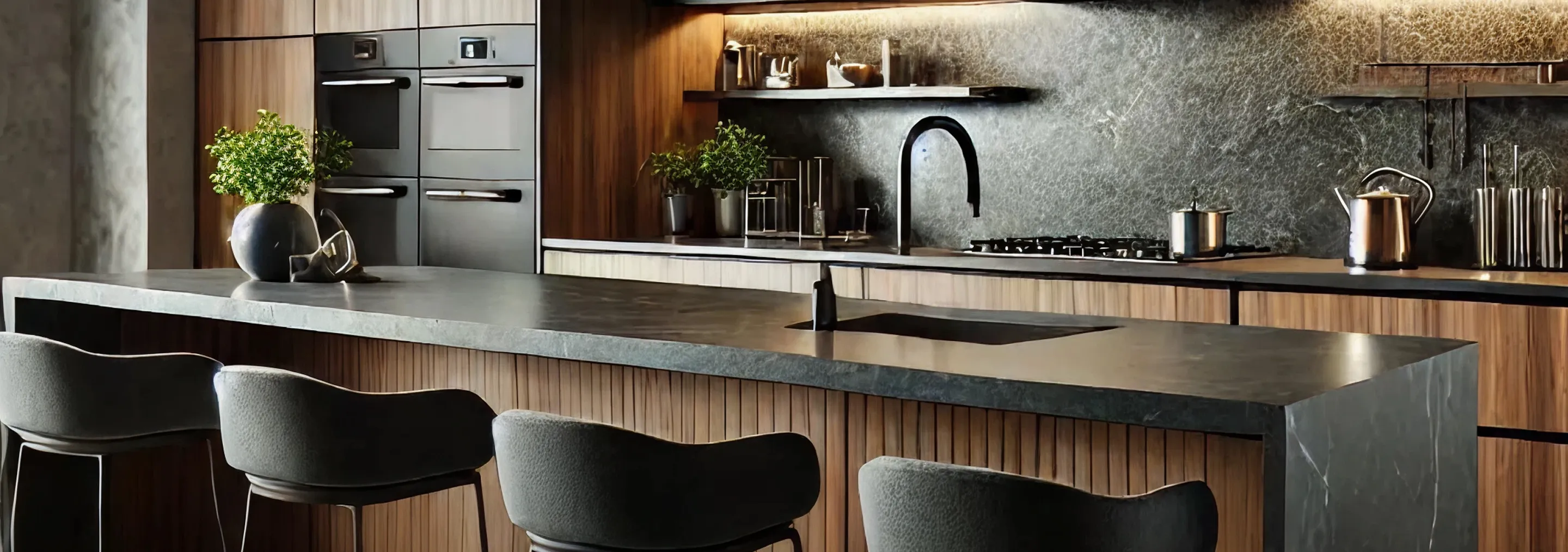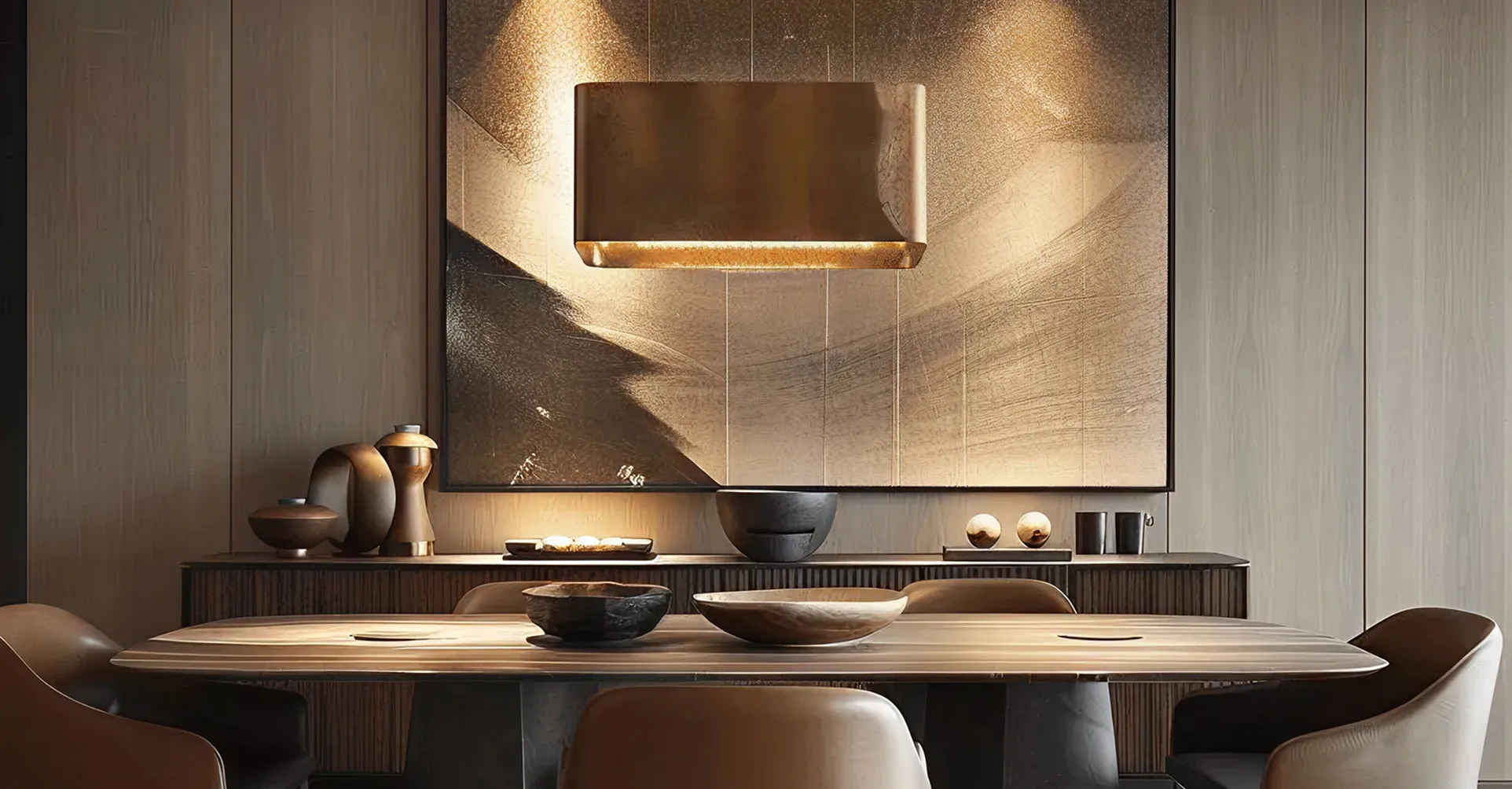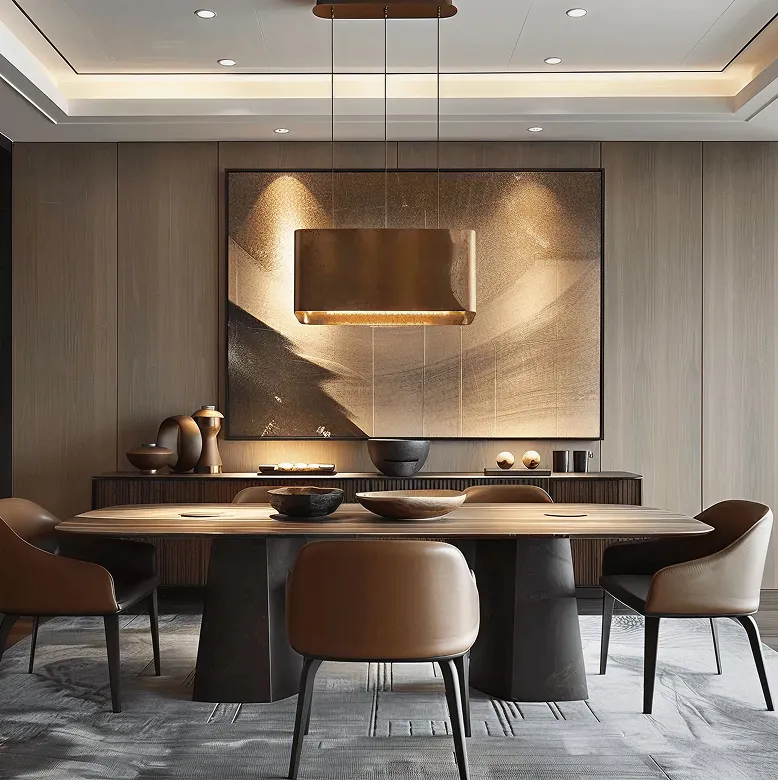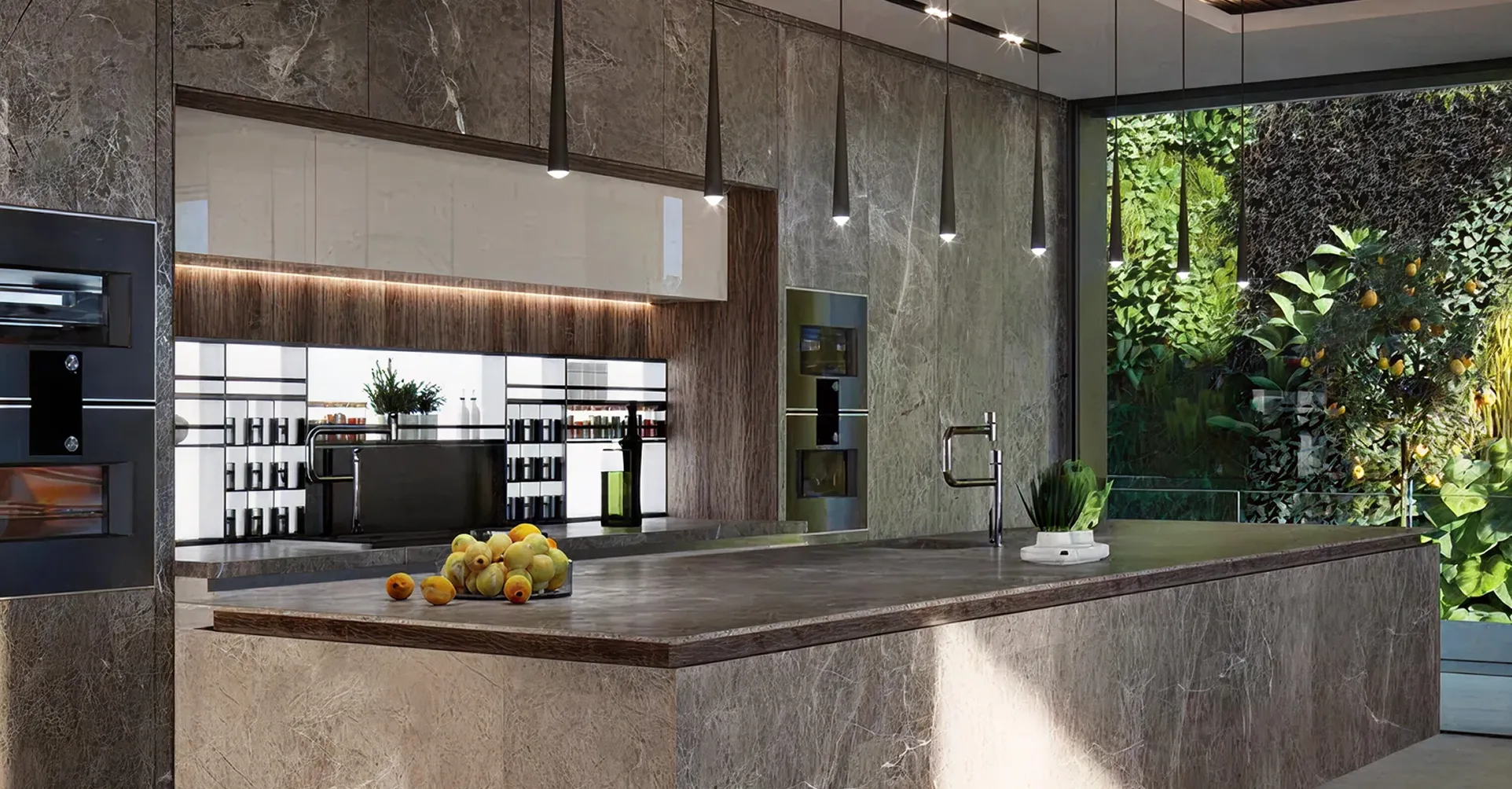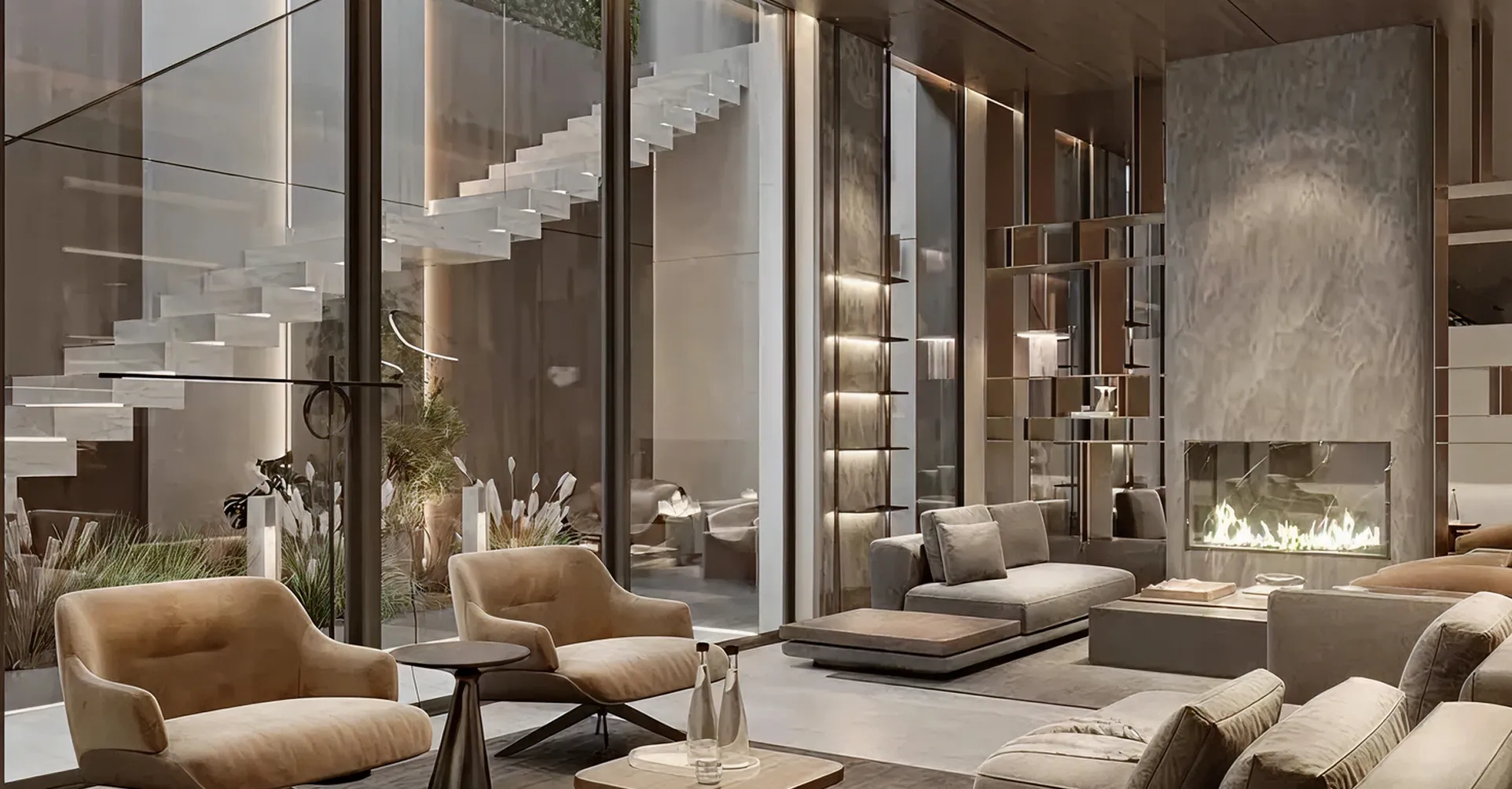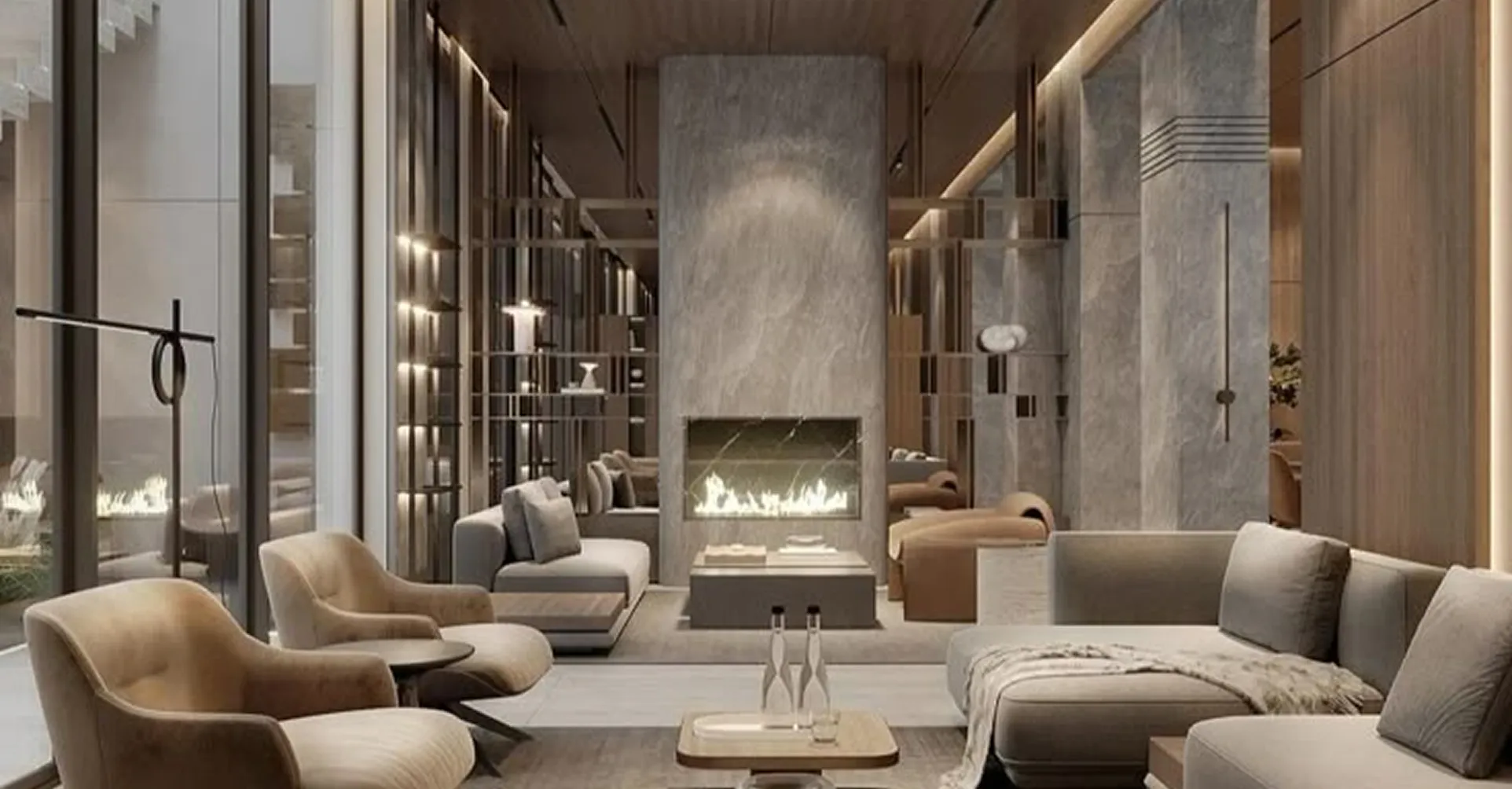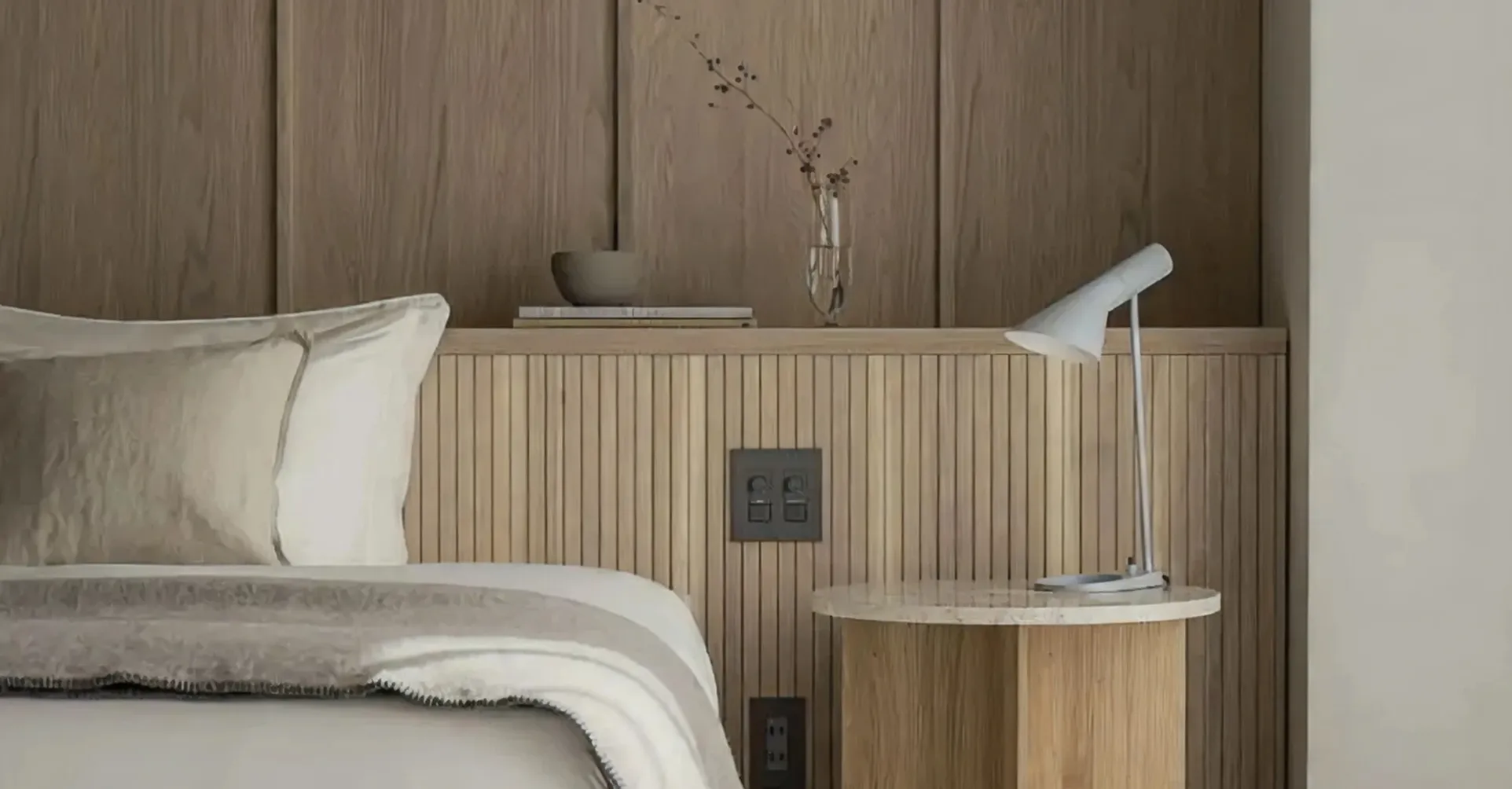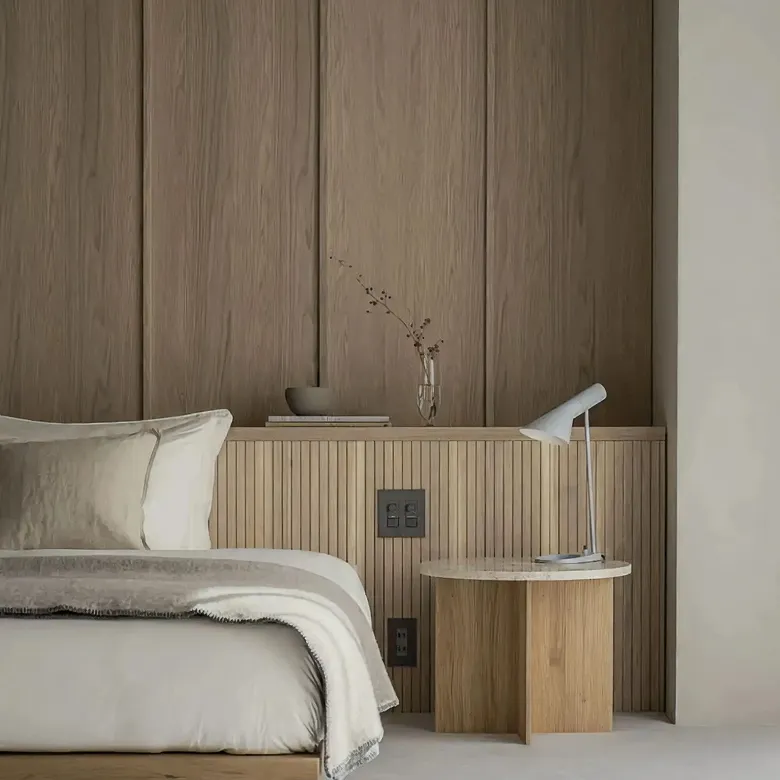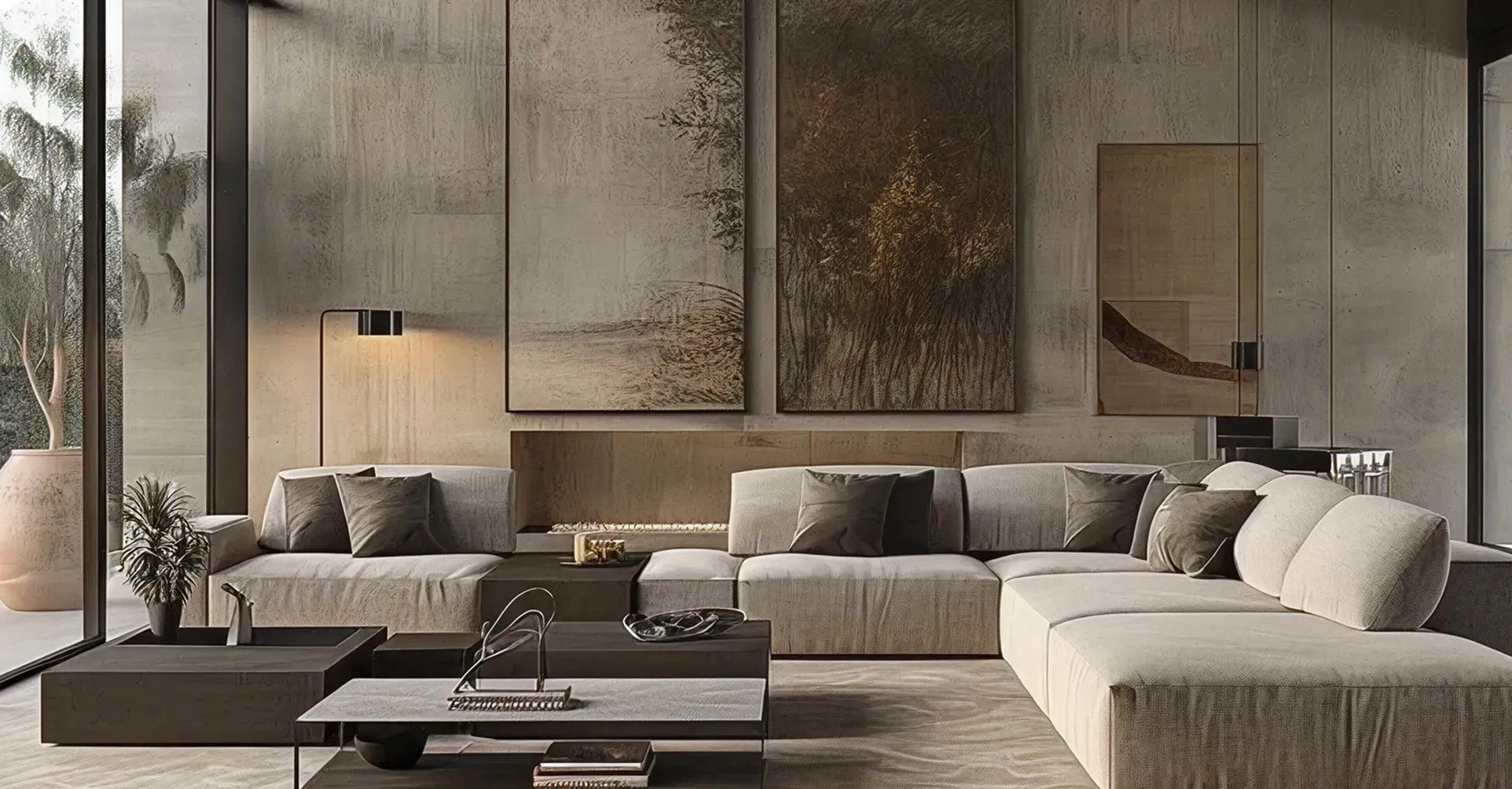Choosing the right interior designer ensures your project aligns with your vision. In this guide, we will walk you through the process of selecting an interior designer in Dubai for your next residential, office, or commercial space. You will learn how to define your project’s scope, set a budget, and find a designer who matches your needs. We will also cover important details like licensing, fees, timelines, and key questions to ask, helping you make a well-informed decision throughout the process. For a detailed view of the complete interior design process, consider exploring our guide on the luxury interior design process.
10 Steps to Choose an Interior Designer in Dubai
1. Define your interior design project scope and set a budget
Before reaching out to an interior designer, clearly outline your project and set a realistic budget. Identify which areas of your villa, apartment, or commercial space you wish to redesign and the level of work required, including decor updates, turnkey fit-outs, or structural modifications. Specify your goals, whether modernizing a kitchen, adding built-in wardrobes, or redesigning a full villa interior. Include a budget that accounts for construction, finishes, and furniture procurement (FF&E). In Dubai, project costs vary widely, simple apartment updates typically range from AED 150–350 per square foot, while high-end villa fit-outs with premium finishes and smart-home integration can exceed AED 1000 per square foot. Establishing scope and budget upfront allows designers to propose solutions tailored to your vision, ensures alignment on expectations, and makes it easier to select an interior designer firm capable of delivering your project efficiently and confidently.
2. Shortlist interior designers by portfolio and style fit
To select the right interior designer in Dubai, begin by reviewing their portfolio and previous work to ensure their experience aligns with the scope and scale of your project. If you are redesigning a villa, prioritize designers who have worked on similar large-scale residential projects, not just smaller spaces like apartments or single rooms. Look for portfolios that reflect the quality of finishes, attention to detail, and clarity of design intent. A portfolio that resonates with your taste indicates the designer’s ability to deliver the desired result. Also, consider project descriptions or case studies, and request before-and-after visuals or client references to better understand their approach. Client testimonials, available on platforms such as Google or Houzz, offer further insight into the designer’s reputation, communication, and ability to meet deadlines. For a comprehensive overview, you can also explore our guide on the Top 10 Interior Design Companies in Dubai to compare experienced firms and their portfolios.
3. Verify credentials, licenses, and local compliance of a Dubai interior designer
When selecting an interior designer in Dubai, verify that they are licensed and knowledgeable about local regulations. A qualified designer will hold a commercial license through the Dubai Economic Department and should be registered with Dubai Municipality, especially if the project requires permits. Confirm that the designer is an approved consultant or has membership with the Society of Engineers, which guarantees they meet local standards. Given the complexity of Dubai's regulatory environment, a capable designer will manage the necessary permits and approvals, including coordination with authorities like Dubai Municipality, Dubai Civil Defense, and utility providers such as DEWA. If your property is within a master development, such as Emaar or Nakheel, a No Objection Certificate (NOC) may also be required. Additionally, ensure the designer has appropriate liability insurance and offers warranties on the work completed. By confirming these credentials, you reduce the risk of legal issues and ensure the project progresses smoothly, avoiding any delays or complications.
4. Discuss design process and timeline expectations
Understanding the design process and timeline is essential in selecting an interior designer in Dubai. A professional Dubai interior designer will outline all stages, including concept development, space planning, detailed design, technical drawings, permit approvals, material procurement, and fit-out execution. It is important to confirm that the designer will handle the project on-site, ensuring coordination with contractors and vendors throughout the process. Request an estimated timeline for each phase, keeping in mind that larger projects like villa renovations can take 5 to 9 months, while simpler designs will be quicker. Be cautious of designers promising overly fast timelines, as this may indicate a lack of realistic planning. Additionally, inquire about how they manage delays, use project management tools, and keep you informed of progress. A well-structured timeline and transparent communication reflect professionalism, helping to set clear expectations and ensure the project runs smoothly. Learn more about the complete interior design process with timelines here.
5. Examine the quality of drawings and documentation
The level of detail in an interior designer's documentation is a strong indicator of their professionalism and the potential success of a project. Well-prepared, quality drawings and specifications guide contractors clearly, reducing the risk of errors, delays, and unexpected costs. A leading interior design firm will provide a comprehensive set of documents, including floor plans, elevations, custom drawings for elements like kitchens and bathrooms, lighting and electrical layouts, and detailed material lists. The Bill of Quantities (BOQ) is another key element, outlining all materials and work items, helping to ensure accurate contractor quotes and avoid costly surprises later on. This document forms part of the contract, ensuring transparency and clarity. It is also important to understand who prepares the BOQ, whether it is done in-house by the designer or by the contractor, with the former providing more impartiality. A designer who maintains a thorough and organized system for revisions and updates, such as marking changes on drawings and documenting design developments, reflects a strong commitment to quality. Clear, detailed documentation is necessary for permit approvals in certain jurisdictions.
6. Check supplier networks and material quality
The quality of an interior design project is shaped by the materials and craftsmanship involved. A designer with strong relationships with trusted suppliers can secure premium materials and manage deliveries efficiently, ensuring a streamlined process. Inquire about their sourcing methods for custom joinery, stone, lighting, and furniture, and whether they provide physical samples for your approval. An interior designer in Dubai committed to quality will inspect custom pieces before they reach your site. If the designer also manages FF&E procurement, they offer added convenience with transparent pricing. A well-established relationship with reliable contractors ensures smooth execution, so ask about their preferred team and consider visiting current project sites to assess their work firsthand. When considering how to select an interior designer in Dubai, prioritize those with a reliable network and a commitment to delivering your vision with precision and high standards.
7. Compare fee structures and included services
The fee structure is an important factor to consider when selecting an interior designer in Dubai. Designers typically offer various pricing models, such as flat design fees, percentages of the total project cost, per square meter rates, or hourly consulting fees. It is important to clarify what is included in the fee, whether it covers project management, site visits, material selection, or procurement, and to understand any additional costs for revisions or markups on furniture and finishes. A clear and transparent fee breakdown helps you avoid surprises during the project. As you learn how to select an interior designer in Dubai, ensure the designer's fees and services are aligned with your expectations and the level of craftsmanship you desire.
8. Review contract terms for clarity and fairness
Before finalizing the hire of an interior designer in Dubai, ensure you have a written contract in place. A well-constructed contract protects both parties and sets clear expectations for deliverables and responsibilities. When reviewing the agreement, pay close attention to the following key points:
- Scope of Work & Deliverables: The contract should explicitly list the services the designer will provide, including the number of design concepts, revisions, drawings, procurement services, and site visits. All promised deliverables should be clearly outlined.
- Project Timeline: The contract may include an expected design schedule or a final project completion date. While timelines can shift, having milestone targets documented ensures clarity.
- Payment Schedule: The contract should detail the fee structure and specify when payments are due; never pay the full amount upfront. The industry standard includes a deposit followed by progress payments tied to completed milestones, such as after the design concept or drawing delivery.
- Changes and Variations: Ensure the contract includes a clause addressing how additional work or scope changes are managed. This should specify that any changes beyond the original agreement must be documented in writing and may involve adjusted fees.
- Intellectual Property: The contract should clarify who owns the design drawings. While you’ll typically have the right to use the plans for your project, the designer usually retains ownership of the design itself.
- Termination Clause: This outlines conditions under which either party can terminate the agreement, along with any obligations if termination occurs (e.g., payment for work completed).
- Warranties/Aftercare: If the designer is also overseeing the fit-out, the contract should mention any warranty period (typically 12 months for defects) and whether the designer will conduct snagging or follow-up inspections.
- Penalties or Liability: While penalty clauses for designers are uncommon, some contracts may outline penalties for significant delays caused by the designer. If your project has a hard deadline, such as a move-in date, it’s important to discuss this and include it in the contract.
If any terms are unclear, don’t hesitate to ask questions or request clarification. Negotiating adjustments at this stage, such as additional site checks or extended aftercare, will help avoid misunderstandings later. Ensure the contract ties payment stages to completed deliverables to prevent any upfront payments without corresponding work. A contract that covers all details, including payment schedules, change orders, and penalties for delays, will set a professional tone and provide peace of mind throughout the project.
9. Visit completed interior design projects or speak to past clients
Before finalizing your decision to hire an interior designer in Dubai, it is essential to verify their credibility through reference checks and, when possible, by visiting past or ongoing projects. Reach out to a few previous clients to inquire about their experience, specifically regarding budget adherence, problem-solving, communication, and overall satisfaction. If the designer hesitates to provide references, it may raise concerns. Additionally, visiting completed projects or requesting high-resolution photos can give you a firsthand look at the quality of work, focusing on details like finishes and craftsmanship. If an in-person visit isn’t possible, ask for snagging reports to see how issues were addressed. It is beneficial to meet the key project managers or team members who will handle the work, such as the project manager or foreman, as their expertise directly impacts the project’s execution. By thoroughly reviewing references and past projects, you can proceed with greater confidence, ensuring the designer is a suitable match for your vision.
10. Consider a paid trial or concept workshop first
If you're uncertain between a couple of designers, consider opting for a paid trial or concept workshop. In Dubai, some clients engage designers for an initial concept or mood board presentation for a single room as a way to assess their suitability. This allows you to evaluate the designer’s creativity, responsiveness to your brief, and how well they understand your vision, all without the risk of committing to a larger project. A paid trial also provides insight into the designer’s approach to problem-solving, especially with unique challenges such as architectural features in Dubai’s homes. During the session, come prepared with inspiration, floor plans, and a list of must-haves, and observe how the designer listens, incorporates your input, and offers innovative solutions. A professional designer will provide real value, potentially introducing ideas you hadn’t considered. If you choose to go this route, be sure to clarify whether the trial fee can be credited towards the full project if you proceed. Ultimately, a successful trial session will allow you to confidently move forward, knowing you have found the right interior designer for your project.
Licensing, Regulations, and Approvals for an Interior Designer in Dubai
Hiring an interior designer in Dubai requires careful attention to licensing and regulatory compliance. Ensuring the designer is qualified, protects your investment, and keeps the project on schedule.
Trade license
Confirm that the interior designer is licensed by the relevant authorities. A valid trade license ensures the designer is legally recognized, accountable, and authorized to operate professionally in Dubai. Hiring a licensed professional reduces the risk of disputes and guarantees credibility.
Dubai Municipality approvals
Ensure they are familiar with the necessary permits for structural or MEP (mechanical, electrical, plumbing) changes. These approvals are mandatory for any modifications that affect building safety or infrastructure. A designer experienced with municipal processes can secure permits efficiently and keep the project on schedule. An established interior designer in Dubai will typically have a dedicated approvals specialist to handle these tasks, further streamlining the process and minimizing delays.
Building/community rules
Always check your building management’s regulations before starting work. Many apartments, villas, and gated communities impose restrictions on construction hours, materials, or structural changes. A knowledgeable designer navigates these requirements to prevent delays, fines, or conflicts with management.
Understanding Fees & Pricing Models
Knowing what to expect in terms of pricing allows you to plan your budget and ensure transparency when engaging an interior designer in Dubai.
Percentage of project cost
For turnkey interior design, including initial concept and supervision, expect fees around 8%-15% of the total project cost for most mid to high-end designers. This model covers comprehensive design services and oversight throughout execution.
Flat packages
Some interior designers in Dubai offer fixed packages. For instance, a full villa design may range from AED 30,000–75,000, while a single-room plan could be AED 5,000–15,000. Fixed packages provide clarity on cost for well-defined projects.
Hourly consultations
Initial meetings or advisory sessions are charged hourly, typically AED 500–1,000 per hour. Many firms credit this fee if the project proceeds, making it a flexible option for clients exploring design ideas. Factors influencing fees include project complexity, bespoke furniture or custom woodwork, detailed drawings for contractors, and the designer’s reputation. Premium or award-winning interior designers in Dubai command higher rates due to expertise and track record.
It is essential to clarify whether the fee includes ongoing site involvement. If not, additional budgeting for a project manager or extra site visits may be necessary. Understanding these models ensures you engage an interior designer in Dubai whose services align with your vision, scope, and budget.
5 Essential Questions to Ask an Interior Design firm
When selecting an interior designer in Dubai, asking the right questions ensures your project is in capable hands and aligns with your vision.
1. Have you worked on similar projects before?
Ask if the designer has completed projects similar to yours. Understanding their experience helps you gauge whether they can deliver the level of quality, attention, and style your project demands.
2. Can I visit a completed project?
Request access to finished projects or a portfolio. Seeing completed interiors demonstrates the designer’s execution, materials, and attention to detail.
3. Who will be managing the project on a day-to-day basis?
Clarify the point of contact and the project manager. Knowing who handles daily coordination ensures smooth communication and progress monitoring.
4. What is your fee structure, and what does it include/exclude?
Discuss the designer’s pricing model and the services covered. This prevents unexpected costs and helps you plan for additional requirements, such as site supervision or custom furnishings.
5. What is your estimated timeline from design to completion?
Ask for a schedule from concept to final handover. Understanding the timeline allows you to plan construction, deliveries, and occupancy efficiently.
Checklist for Hiring an Interior Designer in Dubai
To protect your investment and ensure a smooth project, request the following documents and information from any interior designer in Dubai you consider:
Trade license and insurance
Confirm that the interior designer in Dubai holds a valid trade license and adequate insurance. This ensures they are legally recognized, accountable, and covered in case of accidents, property damage, or project-related liabilities.
Portfolio & references
Ask for recent case studies and client references. Reviewing completed projects and speaking with previous clients provides insight into the designer’s execution, reliability, and design quality.
Contract details
Examine the interior design firm’s standard contract carefully, including terms for cancellations, change orders, and dispute resolution. A clear contract sets expectations, protects your interests, and establishes a framework for smooth collaboration throughout the project.
Key Contract Essentials & Payment Milestones
A detailed contract protects you and your interior designer in Dubai by clearly defining expectations regarding scope, timeline, and budget.
Scope of work
Clearly outline what services are included and excluded in the project. This prevents misunderstandings and ensures that design, execution, and any additional services are accounted for.
Payment schedule
Structure payments to align with project milestones. Linking fees to completed phases, including concept approval, detailed drawings, and site execution, ensures transparency and accountability.
Change order process
Establish a formal process for handling changes or cost adjustments. Clear guidelines help manage unexpected requests, additional work, or modifications without disrupting the overall project flow.
Navigating Permits & Approvals
Certain interior design projects in Dubai require permits, particularly when structural or MEP (mechanical, electrical, plumbing) modifications are involved. Engaging an interior designer in Dubai who understands local regulations ensures compliance and smooth project execution.
Minor cosmetic changes
Simple alterations, such as painting, wallpaper, or furniture layout adjustments, generally do not require permits.
Structural or MEP work
Any changes affecting walls, ceilings, plumbing, or electrical systems typically require approval from the Dubai Municipality. Proper documentation and submission prevent delays or legal complications.
Commercial projects
Fit-outs for retail, F&B, or other commercial spaces may involve multiple permits, NOCs, and approvals from various authorities. A knowledgeable interior designer in Dubai can navigate these requirements efficiently, ensuring your project proceeds without interruptions.
Typical Timeline for Interior Design Projects in Dubai
Understanding realistic timelines allows you to plan effectively and avoid delays when working with an interior designer in Dubai.
Design Phase
For a villa, the conceptual design generally takes 2-4 weeks. Detailed design, drawings, and revisions can take another 4-8 weeks. Smaller apartments may require less time, but larger residential or commercial projects can extend to 2-3 months for the full design phase.
Approvals
Permits and approvals, such as Dubai Municipality or community NOCs, can take 2-6 weeks. Some authorities process simple interior works faster, but major structural or MEP modifications may require multiple approvals, extending the timeline.
Procurement
Ordering materials and furniture overlaps with the approval phase. Locally available items arrive quickly, while imported custom pieces, such as European-made sofas or bespoke joinery, can take 8-12 weeks. Early planning ensures timely delivery and prevents delays.
Execution (Fit-Out Construction)
On-site work duration varies by project type. Small apartment renovations are typically complete in 6-10 weeks. Mid-size villa fit-outs range from 12-20 weeks, and large luxury villas can take 20-36 weeks. This phase covers demolition, structural or MEP work, false ceilings, flooring, painting, joinery, kitchen installation, and other interior finishes. Highly intricate designs or premium materials may extend the timeline.
Handover & Snagging
Allocate 1-2 weeks for final touch-ups and snagging. This is when you, the interior designer, and the contractor review the space, address defects, and finalize quality checks. Final payments are released after snagging is resolved.
Total Project Duration
From initial design kickoff to project handover, a turnkey home interior project typically spans 4-8+ months, depending on scale, complexity, and approvals. Factors like Ramadan, peak summer, or tight deadlines may require adjustments. A skilled interior designer in Dubai can help plan contingencies and optimize the schedule without compromising quality.
Deal-Breakers When Hiring an Interior Designer in Dubai
Hiring the wrong interior designer in Dubai can lead to delays, unexpected costs, and compromised results. Avoid these red flags to safeguard your project, budget, and timeline:
No trade license or insurance
A designer without a valid Dubai trade license or insurance is operating outside legal requirements. Hiring such a designer exposes you to liability risks, project delays, and potential fines. Confirm that all subcontractors involved are licensed and authorized.
Vague or one-line quotes
Quotes that list only a total price without a detailed breakdown are a warning. A proper proposal should itemize costs by room or service, specify materials, and include a clear payment schedule. Vague quotations create room for unexpected charges later.
No portfolio or references
Insist on seeing past projects and, if possible, visiting a completed site. A designer unable to provide a portfolio or credible references may lack the experience needed to deliver a project of your scale or quality expectations.
Unrealistic promises
Be cautious of designers offering excessively low fees or extremely short timelines. Projects in Dubai have standard material and labor costs; underestimating can lead to corner-cutting or additional expenses later.
Poor communication or professionalism
Early interactions reflect how the designer will manage the project. Irregular responses, dismissive behavior, or rescheduling meetings frequently indicate potential management issues during execution.
No contract or rushing to start
Avoid designers who resist formal contracts or propose starting without written terms. A contract ensures alignment on scope, payment milestones, and responsibilities, protecting both parties.
No on-site involvement
Ensure the designer is actively involved during execution. Handing over drawings without supervision can result in misinterpretation by contractors, especially for structural, MEP, or high-end finishes common in Dubai projects.
No after-sales support
Quality designers provide final snagging checks and remain available for post-completion guidance. A lack of aftercare may leave defects unresolved and increase stress after handover.
Trust your instincts. If early interactions feel off, such as aggressive upselling, dismissing your vision, or reluctance to answer questions, walk away. Securing a reliable, experienced interior designer in Dubai is vital for a smooth, high-quality project.
Useful Resources for Verifying Interior Designers
Before committing to an interior designer in Dubai, it is essential to verify their credentials and experience. Reliable sources help ensure your investment is secure and your project runs smoothly:
Dubai Municipality: Contractor Registration & Requirements
Dubai Municipality is the primary regulatory authority overseeing building and construction standards in the city. Interior designers working on residential, commercial, or hospitality projects must be registered with the Dubai Municipality to ensure they are qualified to handle the requirements of your project.
How it helps:
- Registration Check: Verify that your designer is listed as a licensed contractor with the Dubai Municipality. This ensures they are compliant with local laws and regulations.
- Permit Requirements: Any design work requiring structural changes, electrical or plumbing modifications (MEP work), or alterations to the building’s layout will need the approval of Dubai Municipality. Ensuring your designer has the right credentials means your project is less likely to encounter delays due to improper permits.
Where to check:
Visit the Dubai Municipality website to check for registered contractors and find information on licensing and approvals for interior design work in the city.
Consumer Rights: Understanding Protections & Filing Complaints
Consumer rights are a critical aspect of protecting your interests when hiring an interior designer in Dubai. The Dubai Economy (Department of Economic Development - DED) and other regulatory bodies offer consumer protections that ensure you’re not taken advantage of, especially when disputes arise over payments, quality of work, or project delays.
How it helps:
- Consumer Protection: Understanding your rights ensures you are not subjected to unfair practices. If a designer fails to meet agreed-upon terms or produces subpar work, you have the right to file complaints and seek resolutions.
- Dispute Resolution: If any issues arise during the course of the project (e.g., contract disputes, delays, or dissatisfaction with the design), knowing the proper channels for resolving conflicts can save you time, money, and stress.
Where to check:
- The DED Consumer Protection Department offers resources for consumers, including how to file complaints and what steps to take if you feel your rights have been violated.
- Also, explore the Dubai Consumer Protection website for more information on consumer rights laws specific to contracting, interior design, and construction services.
Client Feedback & Reputation Check
In today’s digital landscape, Google Reviews are one of the most accessible and transparent ways to evaluate an interior designer’s credibility and client satisfaction.
How it helps:
- Real Client Experiences: Browse feedback from previous clients to get an honest sense of the designer’s professionalism, communication, and quality of work.
- Compare Firms Easily: You can compare several interior design firms side by side to find one that aligns with your expectations and project style.
- Authenticity Check: Reputable companies typically respond professionally to both positive and negative reviews, reflecting transparency and accountability.
Where to check:
Simply search the interior designer or interior design firm’s name on Google Maps or Google Search, and review the star rating, photos, and comments from previous clients.
Rayfitout: A Trusted Interior Design Firm in Dubai
Rayfitout stands as a trusted interior design firm in Dubai, known for delivering projects that reflect purpose, comfort, and premium quality. The projects are approached with careful understanding of the client’s vision, ensuring that design decisions align with lifestyle, function, and long-term value. The process is transparent, organized, and guided by commitment to detail and bespoke craftsmanship.
Why choose Rayfitout as your interior designer in Dubai?
Decades of Experience
As a leading interior design firm in Dubai, Rayfitout has completed a wide range of residential and commercial projects across the UAE. Years of hands-on experience with local construction standards, material sourcing, and regulatory requirements ensure projects run smoothly and efficiently.
Expert Team
The firm brings together designers, architects, engineers, and project managers who guide every stage. Their expertise ensures clarity and consistency in concept design, documentation, procurement, and fit-out execution.
Rayfitout provides comprehensive solutions as a turnkey interior designer in Dubai, handling all aspects of a project.
Timely Execution
Project milestones and progress updates keep work on schedule. Site supervision ensures every detail aligns with the original vision.
Rayfitout stands as an interior design firm with decades of experience, combining careful planning, technical accuracy, and enduring quality. Each project is handled with dedication, professionalism, and a commitment to results with bespoke joinery and craftsmanship.
Making the Right Choice for Your Interior Design Project in Dubai
Choosing the right interior designer in Dubai is essential for a project that delivers lasting quality and refined results. Begin by defining the scope, priorities, and budget to guide expectations. Research and shortlist interior design firms with portfolios and referrals that demonstrate relevant experience and completed projects. Verify credentials, including trade licenses, insurance, and familiarity with Dubai Municipality approvals. Engage in detailed discussions to assess expertise, timelines, and fee structures, and review proposals carefully to ensure alignment with your objectives and budget. Establish clear terms in the contract, including deliverables, payment milestones, and processes for managing changes. Prioritizing a designer with decades of experience and a proven track record ensures your project is executed professionally, on schedule, and results in a space that reflects your vision.
